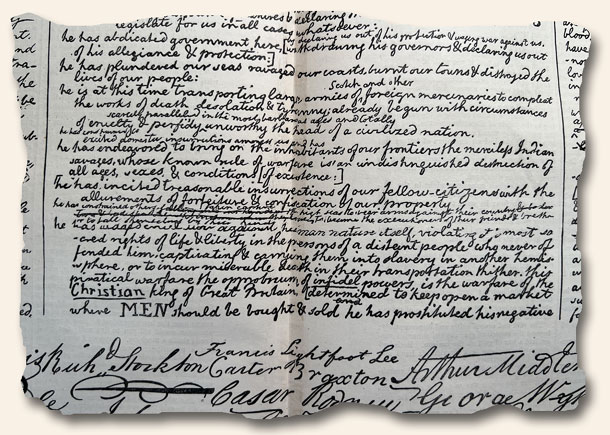Harper’s Weekly… A Journal of Civilization…
December 26, 2022 by Laura Heilenman · Leave a Comment
 Last week, as I was preparing a January 22, 1898 Harper’s Weekly for shipment, I noticed it was to be sent to Japan. We at Rare & Early Newspapers love knowing our collectors span the Globe; in fact, on a wall in the shipping department we track all the countries where our issues now reside.
Last week, as I was preparing a January 22, 1898 Harper’s Weekly for shipment, I noticed it was to be sent to Japan. We at Rare & Early Newspapers love knowing our collectors span the Globe; in fact, on a wall in the shipping department we track all the countries where our issues now reside.

Although I knew we had sent many collectible newspapers to this region, I was still curious to see if there might be a cultural motivation behind the purchase. As I paged through the issue to see what may have caught the attention of our Japanese collector, near the back I discovered 4 pages of beautiful prints with the heading, “The Porcelain Arts of Japan”. Full certain this gentleman would be pleased with such charming illustrations, I was delighted knowing this historical treasure would make its way across the World to his collection. As I closed the pages to resume my task my eyes fell on the tagline used by Harper’s Weekly Illustrated: “A Journal of Civilization”.
How appropriate to have noticed their description at this moment and how sublime to know we have a community of collectors which extends across all of today’s civilization.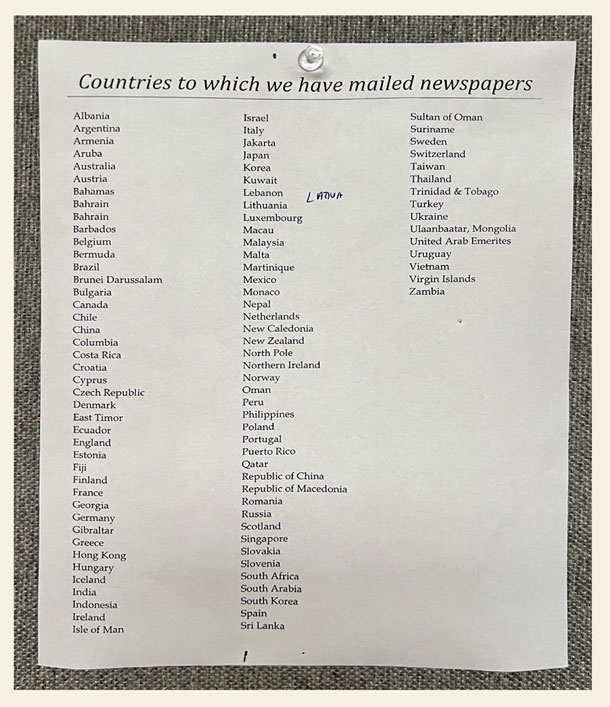
19th century Harper’s Weekly reviewed…
December 11, 2017 by GuyHeilenman · 2 Comments

Over the years we have made several mentions of Harper’s Weekly, one of the most beloved illustrated newspapers of the 19th century. This title is also one of the most sought-after collectibles through our website,
RareNewspapers.com. Although I’m sure many others exist, I was pleasantly surprised to find a contemporary review of this publication on the front page of the Springfield Republican dated February 13, 1867. Even more pleasing was my discovery that, unlike It’s a Wonderful Life, the works of Vincent Van Gogh, and Thoreau’s Walden, along with a host of other now-popular people, songs, products, books, etc., which initially found it difficult to gain traction, at least in one journalist’s opinion was seen as an unrivaled, gem of a publication. Their review stated, in part:
“The Harpers offer their Weekly in bound volumes for the year 1866 for $7. As a record and illustration of the times, it has no rival; its pages are history, literature and politics, all of the safest and soundest sort. Good as are the Harper’s pictures for America, valuable as its record of passing events, and interesting as are generally its sketches and stories…” (view entire article).
The link RareNewspapers.com will take you to our website where nearly every Harper’s Weekly has been photographed and described for your reading and viewing pleasure. Please enjoy.
Harper’s Weekly: a magazine or a newspaper?
December 12, 2016 by TimHughes · 4 Comments
I’ve always referred to it as a newspaper to distinguish it from their own sister publication “Harper’s New Monthly Magazine” which, being smaller, many more pages, and issued monthly, is 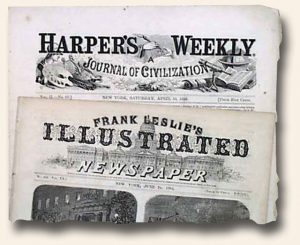 a more definitive magazine. Early in its history the weekly called themselves a “family newspaper”, and modeled themselves against “Frank Leslie’s Illustrated Newspaper” which began about a year earlier. If Leslie’s was a “newspaper” then certainly Harper’s Weekly was a “newspaper” as well.
a more definitive magazine. Early in its history the weekly called themselves a “family newspaper”, and modeled themselves against “Frank Leslie’s Illustrated Newspaper” which began about a year earlier. If Leslie’s was a “newspaper” then certainly Harper’s Weekly was a “newspaper” as well.
However, in Mott’s “History of American Magazines” he includes a section for Harper’s Weekly, as well as one for Leslie’s Illustrated Newspaper and other similar weeklies. Then he confuses the issue a bit more in the second volume of his book (pg. 43) by stating: “Half a dozen copiously illustrated weeklies of general appeal must be grouped separately. It would not be inappropriate to classify these periodicals as newspapers, since they all relied much upon the reporting of current events: indeed, one of them called itself a newspaper in its title. But they were all very much more than newspapers, and they placed the emphasis on features of appeal which belonged more characteristically to the magazine than to the newspaper–namely, pictures and belles-lettres…”.
Thomas Nast in Harper’s Weekly…
March 1, 2013 by TimHughes · 2 Comments
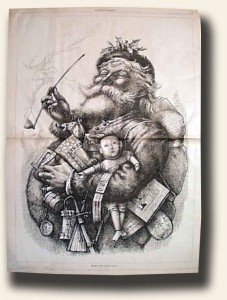 Thomas Nast ranks as one of the most successful, powerful, and prolific artists of the 19th century, and is a name linked closely to one of the most successful, powerful, and prolific newspapers of the 19th century. Through their successes, both Nast and Harper’s Weekly gained sufficient power to influence American politics in the second half of the 19th century and help shape the political climate of America during the industrial revolution.
Thomas Nast ranks as one of the most successful, powerful, and prolific artists of the 19th century, and is a name linked closely to one of the most successful, powerful, and prolific newspapers of the 19th century. Through their successes, both Nast and Harper’s Weekly gained sufficient power to influence American politics in the second half of the 19th century and help shape the political climate of America during the industrial revolution.
Thomas Nast was German born, moving to America in 1846. Skilled as an artist, he first went to work for Frank Leslie’s Illustrated Newspaper in 1859, but within 3 years he began working for its competitor, Harper’s Weekly. His work continued to appear in Harper’s thru 1886.
It was a symbiotic relationship for the two. Circulation of Harper’s Weekly grew as Nast drawings were found in more and more of its pages, and Nast‘s notoriety and popularity grew in large part to the increased circulation of Harper’s Weekly. Nast‘s powerful pen in support of the prosecution of the Civil War was honored by President Lincoln when he called Nast “our best recruiting sergeant”.
With original artwork by Thomas Nast commanding prices far beyond the pocketbooks of most collectors, prints found in Harper’s–and only in Harper’s–remain a popular way to assemble a collection of this famed artist’s work at relatively low prices given the current availability of genuine issues.
For today’s collector, interest in Nast falls into three categories:
1) His portrayal of battles & events of the Civil War, which often featured human interest themes & the effect of the war on those back home, remain as some of the best and most heart-felt scenes of the Civil War. Daily newspapers only provided written text; Harper’s Weekly and the prints of Thomas Nast provided a visual representation of the reality of war.
2) Perhaps most noticed as a political cartoonist, his work did much to expose the graft and corruption of William “Boss” Tweed, the powerful Tammany Hall political machine of New York City. In fact it was a Nast cartoon which caused Tweed to be arrested following his escape from jail and flight to Spain. A customs official recognized him from his many appearances in “Harper’s Weekly”. Nast has been credited with doing much to cause elections of all in the hands of those he supported (Grant’s two Presidencies), and cause to fail those he disliked.
 It was Nast who created the caricatures of the Democratic donkey and the Republican elephant to represent those parties, political icons which remain to this day. Desired among collectors are the first donkey to appear in the pages of Harper’s Weekly (January 15, 1870) and the first elephant to appear (November 7, 1874), as well as the first time they appeared together (December 27, 1879). All three command premium prices due to their desirability, but collectors are encouraged by the inexpensive prices for other genuine issues of Harper’s which include Nast illustrations of both.
It was Nast who created the caricatures of the Democratic donkey and the Republican elephant to represent those parties, political icons which remain to this day. Desired among collectors are the first donkey to appear in the pages of Harper’s Weekly (January 15, 1870) and the first elephant to appear (November 7, 1874), as well as the first time they appeared together (December 27, 1879). All three command premium prices due to their desirability, but collectors are encouraged by the inexpensive prices for other genuine issues of Harper’s which include Nast illustrations of both.
3) Santa Claus prints. It is Thomas Nast who is credited with creating the modern version of Santa Claus, the jolly, rosy-cheeked, rotund purveyor of gifts in the uniform as we know him today. Nast’s first Santa Claus to appear in Harper’s Weekly was titled “Santa Claus in Camp” from during the Civil War, appearing on the front page of the January 3, 1863 issue. Yet it is the January 1, 1881 issue which has the Santa Claus centerfold which still appears in many Christmas advertisements and is perhaps his most famous rendition. There are many issues of Harper’s Weekly which have Santa Claus prints, all very desired among collectors.
True to any symbiotic relationship, with Nast leaving Harper’s Weekly at the end of 1886, he lost his forum to reach the masses, and in losing Nast, Harper’s Weekly lost its political importance. Nast continued his work in other publications, none being very successful, until his death in 1902 to yellow fever. Harper’s Weekly never regained its success from the Nast years, and it ultimately ceased publication in 1916.
Harper’s Weekly issues with Nast prints are very displayable, particularly those which feature Nast images on the front page, or notable icons such as popular politicians, Santa Claus, Uncle Sam and Abraham Lincoln. A very famous Nast cartoon featuring Lincoln is the “Long Abraham Lincoln A Little Longer” cartoon which is in the November 26, 1864 issue, signifying his successful second Presidential election.
All issues offered by Hughes Rare & Early Newspapers are genuine & complete in 16 pages, save for a few described otherwise. In many cases two or three Nast prints appear in one issue.
Creating Harper’s Weekly engravings: a fascinating process…
March 23, 2009 by TimHughes · 14 Comments
 Harper’s Weekly issues of the 19th century remain among the more popular in our inventory, as the multiple engravings found in each issue document much of American history from 1857 through the end of the century. We have over 60,000 issues in inventory but still some dates are sold out as soon as they arrive. I suspect most of you have seen this title, but few may be aware of the interesting process of creating the prints in a timely manner.
Harper’s Weekly issues of the 19th century remain among the more popular in our inventory, as the multiple engravings found in each issue document much of American history from 1857 through the end of the century. We have over 60,000 issues in inventory but still some dates are sold out as soon as they arrive. I suspect most of you have seen this title, but few may be aware of the interesting process of creating the prints in a timely manner.
 The story of how Harper’s delivered this amazing product during the Civil War is a fascinating one, and I must give credit to www.sonofthesouth.net for much of detail.
The story of how Harper’s delivered this amazing product during the Civil War is a fascinating one, and I must give credit to www.sonofthesouth.net for much of detail.
The process started by the deployment of not only reporters but also artists to the battlefield. Some of the most renowned artists of the 1800’s got their start as illustrators for Harper’s Weekly, including Winslow Homer and Thomas Nast. These artists would sketch scenes of the battles that they witnessed and the sketches would then be dispatched back to Harper’s for publication in the upcoming papers.
In order to publish the artwork, the images first had to be carved onto a block of wood. But it would take too much time for a single engraver to carve an entire print, particularly given the timeliness of each issue. To provide the illustrations as quickly as possible, a very clever idea was developed. The illustration would be cut into 2 inch squares and each square would be engraved onto a different small block of wood by an assigned carver.
 By dividing the illustration up, each artist assigned to just a portion, a team of workers could carve a full page illustration in a short period of time. After the small blocks were completed they were then screwed together to form the overall illustration and a finishing engraver would provide final touches to be sure the pieces were perfectly aligned. This completed wood block was then used as a “master” to stamp the illustration onto all the newspapers being printed. If you look at a Harper’s engraving carefully you can often see where the blocks of wood were joined together.
By dividing the illustration up, each artist assigned to just a portion, a team of workers could carve a full page illustration in a short period of time. After the small blocks were completed they were then screwed together to form the overall illustration and a finishing engraver would provide final touches to be sure the pieces were perfectly aligned. This completed wood block was then used as a “master” to stamp the illustration onto all the newspapers being printed. If you look at a Harper’s engraving carefully you can often see where the blocks of wood were joined together.
It wasn’t until the 1890’s that the technology of printing caused the end of hand-done engravings for the pages of Harper’s and other illustrated periodicals. With the demise of this labor-intensive trade also came the end of some of the more beautiful works of art to be found on paper. They remain treasures today and hearken back to an era when artistry and long hours of work were an important part in providing the news.
Capturing the Vibe… Christmas 1903…
December 8, 2023 by Laura Heilenman · Leave a Comment
Welcome to the 2nd post in our ongoing series “Capturing the Vibe” where we try to imagine what the world felt like to a newspaper reader from the past by immersing ourselves in their … “vibe of the day”. This month I was drawn to Illustrated Magazines as Christmas is right around the corner, and they usually offer a plethora of wintery images. 1903 was on a low shelf and so it called my name.
So, on we go with this month’s issue…
Sometimes the December 1900’s colored covers are Christmas related and sometimes they are just beautiful!
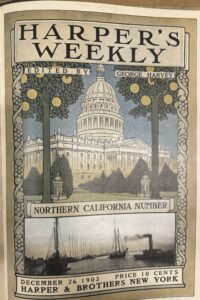
Even though the color cover wasn’t Christmassy, the inside cover was full of Winter spirit.
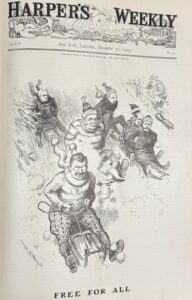
On a somber note, I found a fascinating article comparing Feast-days with Fast-days … not something you hear in conversations of our days.
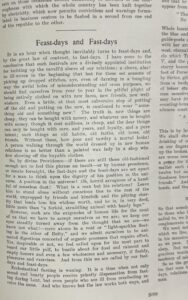
On a somewhat lighter note, I saw a multiple cell comic strip on “Pledges of Purity for the New Year”.
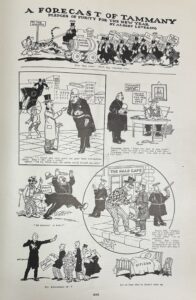
There was an article and intricate image of the New Williamsburg Bridge Christening in New York City…
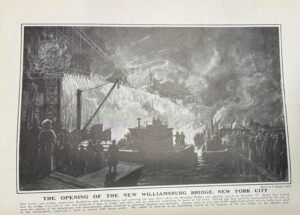
A story by Robert Chambers…
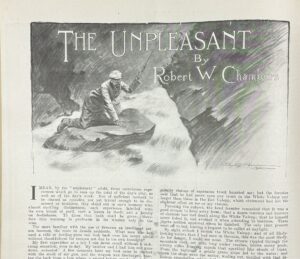
and finally, a political Santa cartoon by W.A. Rogers who took over for Thomas Nast when he left Harper’s Weekly.
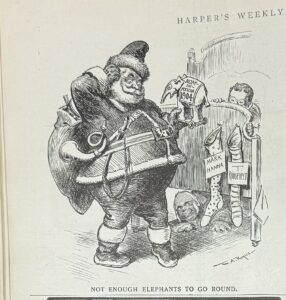
I count this find as an issue full of Christmas gifts!!
Happy Thanksgiving, 2023…
November 17, 2023 by GuyHeilenman · Leave a Comment
Each year as Thanksgiving approaches my thoughts (rightfully) bend a knee in the direction of gratitude which I try to express, for better or worse, in a simple post. In so-doing, while the feedback has been generally positive, on occasion I have been accused of being rather verbose, loquacious, over-talkative, etc., when what I tried to communicate could have been delivered with a higher degree of eloquence with considerably less long-windedness (i.e., I can be a bit wordy). In an effort to reign in this default behavior, in expressing this year’s thoughts I’ve elected to let a series of photos taken from a single issue of Harper’s Weekly from 1900 do the talking. I hope you find them thought-provoking. 
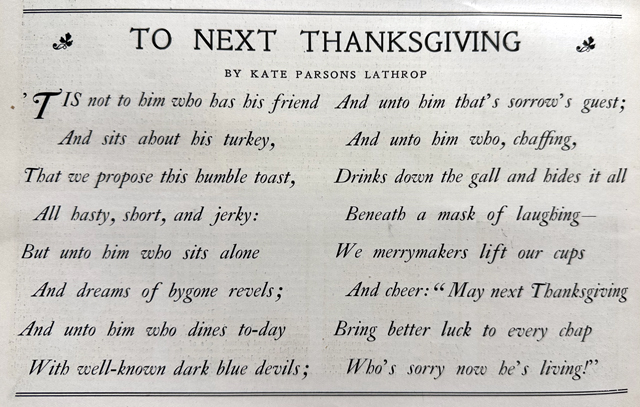


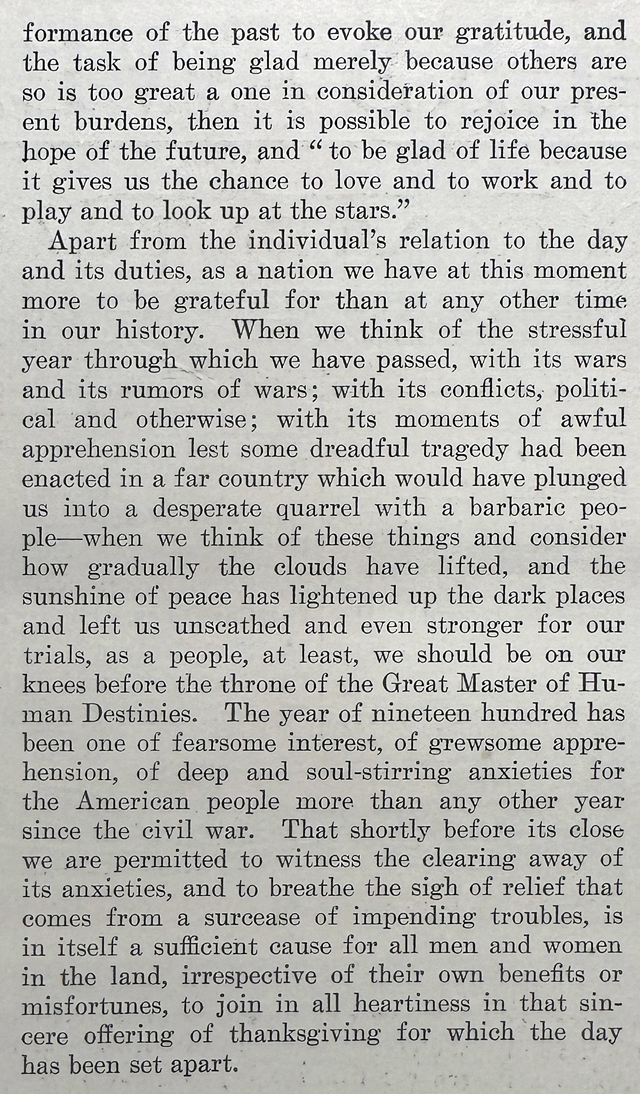
Happy Thanksgiving!
By the way, if pictures really do say a thousand words, success! My verbose, loquacious, over-talkative streak lives on!!!
The meanderings of those who collect Rare & Early Newspapers…
August 11, 2023 by GuyHeilenman · Leave a Comment
One of the more difficult challenges the staff at Timothy Hughes Rare & Early Newspapers face on a near-daily basis is to not be (too often) distracted by that which makes the hobby itself so interesting: that is, that one never knows what one may find while perusing an old newspaper… nor where it may lead. In other words, to not become endlessly distracted. It really is the “back in the good old days” version of surfing the web. This isn’t to say the meanderings are bad per se, for if we permit ourselves to be carried away for a period of time there is much to learn; however, if permitted to get out of hand the phone would be ringing off the hook from collectors wondering why their purchases, which will likely lead to their own meanderings, have yet to ship. Combining the old (rare newspapers) with the new (the internet) has only exacerbated the temptation.
One minor instance occurred just a few weeks ago which, if you have a few minutes to spare, I’d like to share with you.
We recently purchased a set of The National Era which included many of the original installments of the serialized printing of Uncle Tom’s Cabin by Harriet Beecher Stowe. While tagging the issues which contained segments of her profoundly culture-altering novel, we noticed several issues which did not have portions still contained related articles. This led us to do an internet search for additional titles (newspaper publications) which had Uncle Tom’s Cabin themed coverage… and this is where the fun began.
I expected the big boys (The New York Times, Tribune, and Herald, along with other notable papers such as the Philadelphia Inquirer and The Liberator) to have mentions. However, I did not expect to see coverage of the book in The Saturday Evening Post – and as fate would have it, the issue referenced was one buried deep within our archives. Off I went to find the July 29, 1865 issue. Hoping for a glorious, detailed report, what I found instead was a poem with a mere mention. Still, although a bit disappointed, I was intrigued by the first line of the article: “There are fragments of songs that nobody sings”, by B. F. Taylor. After having my curiosity piqued by the line, and my sleeping heart stirred by the article itself, I headed back to the internet to find the text of the entire poem (which turned out to be significantly more challenging – dare I say time-consuming – than expected). Once found and read, the entirety of the trek to this point caused me to sense the tension between hope and sorrow… which led me to wonder how those who lived in the mid-1800’s morphed from anger (having read Uncle Tom’s Cabin), to hopelessness (seeing little-to-no change in the state of slavery since their “forefathers” had agreed it should be abolished, but did not do so for fear that the doing so would cause their quest to become a “united” group of states to fail), to hope in a trickle… and then a stream… and then a flood… and then a bloody tidal wave called the American Civil War… to deep sorrow (for the sins of the past and deadly consequences thereof), to restored hope and wonder (in what the future might hold).
Although at this point I could hear my daily tasks calling, this mental excursion was not to be stifled for it had caused me to recall a certain illustration from the cover of the Harper’s Weekly dated November 3, 1866) – a woodcut print of which I was familiar, yet one I had never taken the time to read the blurb describing it. Not wanting to let my travels come to an end with a whimper, I read the short description – And this led me to my final question and motivation for writing this verbose post: When/how did the moniker “Uncle Tom”, born from the text which had been instrumental in vanquishing slavery, morph from being a term of endearment to a gross insult? While the road I had taken did not lead me to new “finds” within our inventory, it did awaken my heart to the plight of slavery and my mind to the understanding of why a nickname which had once been bestowed on someone with kindness and admiration had transformed into one of the greatest cultural (and political) insults aimed at black Americans. The latter I learned by one more trip to the internet: When ‘Uncle Tom’ Became an Insult
The following photos provide a visual glimpse of my meanderings, with the poem by B. F. Taylor saved for last. If you made it this far, thanks for indulging me. Please know if you decide to start collecting rare and early newspapers, this condition is highly contagious. If you already are a collector, you already know.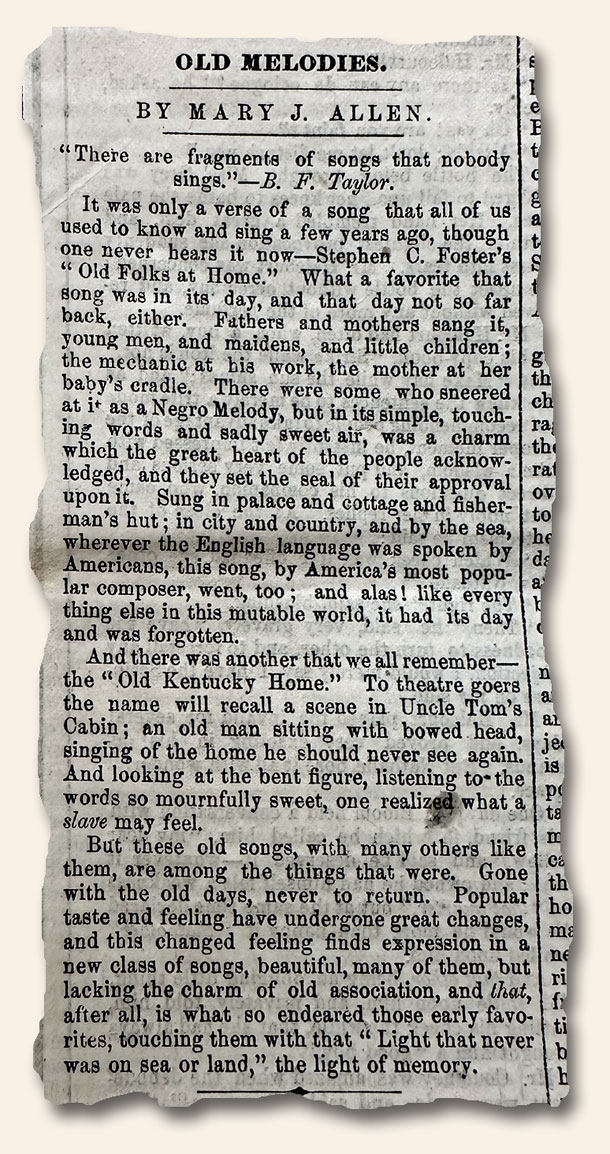

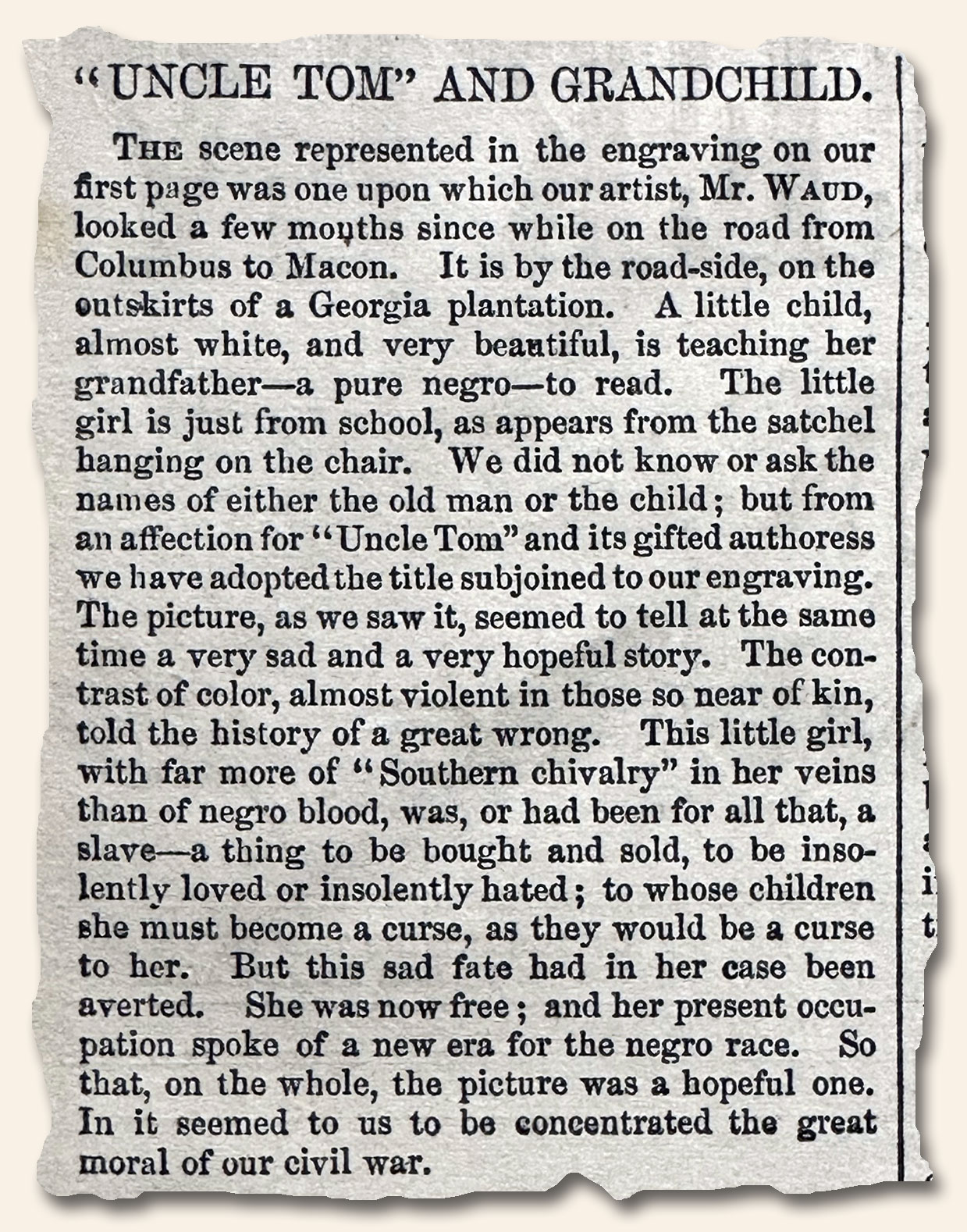

Christmas in July…
July 28, 2023 by Laura Heilenman · Leave a Comment
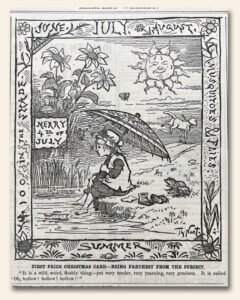 We all have those moments when a memory comes flooding back with all the delight or despair the original moment generated. Such was the case earlier this week as I was organizing a new our new acquisition of Harper’s Weekly Illustrated issues. After working my way through several years, I paused to sort through a stack of Christmas issues. Although it’s the middle of summer and the temperature outside regularly toys with 3-digits, my mind darted back to a midsummer day 20+ years ago when Guy and I were hiking part of the Loyalsock Trail in the Endless Mountains of Pennsylvania. As we were walking along the trail near where we had set up our tents, we thought it odd to hear Christmas music in the distance, however, as we turned off the path and prepared to cross a stream we were amused and entertained by dozens of families and friends celebrating “Christmas in July” right in the middle of the woodland path. Their generator running to power countless strings of Christmas lights, music pumping, and tables crowded with homemade goodies – this family event was in full festive swing.
We all have those moments when a memory comes flooding back with all the delight or despair the original moment generated. Such was the case earlier this week as I was organizing a new our new acquisition of Harper’s Weekly Illustrated issues. After working my way through several years, I paused to sort through a stack of Christmas issues. Although it’s the middle of summer and the temperature outside regularly toys with 3-digits, my mind darted back to a midsummer day 20+ years ago when Guy and I were hiking part of the Loyalsock Trail in the Endless Mountains of Pennsylvania. As we were walking along the trail near where we had set up our tents, we thought it odd to hear Christmas music in the distance, however, as we turned off the path and prepared to cross a stream we were amused and entertained by dozens of families and friends celebrating “Christmas in July” right in the middle of the woodland path. Their generator running to power countless strings of Christmas lights, music pumping, and tables crowded with homemade goodies – this family event was in full festive swing.
Jumping back to the present…
With a smile on my face at the thought of this communal celebration, I grabbed my stack of Christmas issues and headed back up to the front office to share them with all of you through this post. Below you will find a few I’ve listed. We may only have only one 1st-rate issue of each of these, there are plenty of similar to choose from on this hot day in July: Christmas-Themed Harper’s Weekly.
Sample Harper’s Weekly w/ a Christmas Theme
The Declaration of Independence – Jefferson’s Original Draft…
July 14, 2023 by Laura Heilenman · Leave a Comment
Question of the day… Who recognizes the following quote?
“He has waged cruel war against human nature itself, violating its most sacred rights of life & liberty in the persons of a distant people who never offended him, captivating & carrying them into slavery in another hemisphere or to incur miserable death in their transportation thither. The opprobrium of infidel powers, is the warfare of the CHRISTIAN king of Great Britain, determined to keep open a market where MEN should be bought and sold he has prostituted his negative for suppressing every legislative attempt to prohibit or to restrain this excusable commerce and that this assemblage of might want no fact of distinguished die, he is now exciting those very people to rise in arms among us, and to purchase that liberty of which he has deprived them, by murdering the people on whom he also intrude them: thus paying off former crimes committed against the Liberties of one people, with crimes which he urges them to commit against the lives of another.”
If you had asked me a week ago (on July 4th), I would have had no idea. However, as of noon the following day I’ll never forget it. The above quote is from the original draft of the Declaration of Independence. Thomas Jefferson had penned these passionate words denouncing slavery in the original draft. Sadly, delegates from 2 of the 13 colonies would not sign the “declaration” if they were included. Playing the long-game, Jefferson removed them from the first draft with the hope of fighting another day. As I searched the internet for the exact wording, I became distressed when I could not easily find the text from this brilliantly written outcry against evil. What if these exact words were lost to we the people… the common folk? Then, as if by a miracle (albeit with a small “m”), as I was looking through a Harper’s Weekly dated July 8, 1876, I discovered: “FAC-SIMILE OF THE ORIGINAL DRAUGHT BY JEFFERSON OF THE DECLARATION OF INDEPENDENCE” within the rarely-included Supplement. I immediately scanned for what I knew to be the opening line of this “missing” portion… “He has waged cruel war against human nature itself…”, and voilà, there it was! History preserved in a Harper’s Weekly for all to see. I breathed a sigh, slid it into a protective folder, and laid it gently on my desk. Yet another reason why I love this job!!!!!!!!!!!!!!!
PS Based upon what is known about Jefferson’s personal “ownership” of slaves, some may argue his thoughts were hypocritical (or at least blatantly insincere). Perhaps they are right… or, perhaps such an assessment is a bit more complicated. Regardless, it is nice to know many of our Founders wanted to end this inhumane institution. 